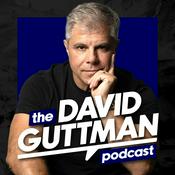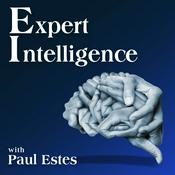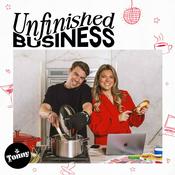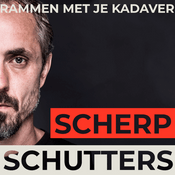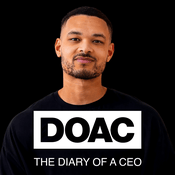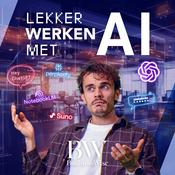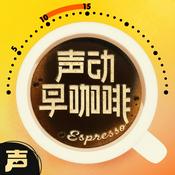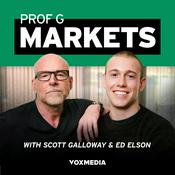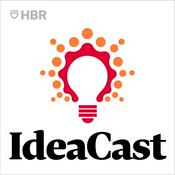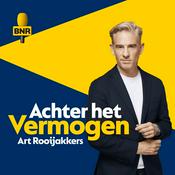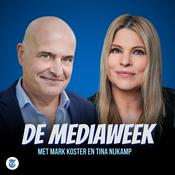Latent Space: The AI Engineer Podcast
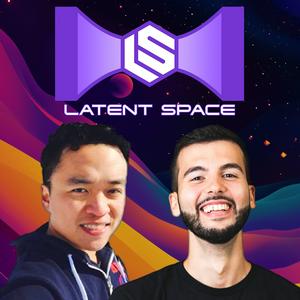
180 afleveringen

[State of Evals] LMArena's $1.7B Vision — Anastasios Angelopoulos, LMArena
06-1-2026 | 24 Min.
We are reupping this episode after LMArena announced their fresh Series A (https://www.theinformation.com/articles/ai-evaluation-startup-lmarena-valued-1-7-billion-new-funding-round?rc=luxwz4), raising $150m at a $1.7B valuation, with $30M annualized consumption revenue (aka $2.5m MRR) after their September evals product launch. —- From building LMArena in a Berkeley basement to raising $100M and becoming the de facto leaderboard for frontier AI, Anastasios Angelopoulos returns to Latent Space to recap 2025 in one of the most influential platforms in AI—trusted by millions of users, every major lab, and the entire industry to answer one question: which model is actually best for real-world use cases? We caught up with Anastasios live at NeurIPS 2025 to dig into the origin story (spoiler: it started as an academic project incubated by Anjney Midha at a16z, who formed an entity and gave grants before they even committed to starting a company), why they decided to spin out instead of staying academic or nonprofit (the only way to scale was to build a company), how they're spending that $100M (inference costs, React migration off Gradio, and hiring world-class talent across ML, product, and go-to-market), the leaderboard delusion controversy and why their response demolished the paper's claims (factual errors, misrepresentation of open vs. closed source sampling, and ignoring the transparency of preview testing that the community loves), why platform integrity comes first (the public leaderboard is a charity, not a pay-to-play system—models can't pay to get on, can't pay to get off, and scores reflect millions of real votes), how they're expanding into occupational verticals (medicine, legal, finance, creative marketing) and multimodal arenas (video coming soon), why consumer retention is earned every single day (sign-in and persistent history were the unlock, but users are fickle and can leave at any moment), and his vision for Arena as the central evaluation platform that provides the North Star for the industry—constantly fresh, immune to overfitting, and grounded in millions of real-world conversations from real users. We discuss: The $100M raise: use of funds is primarily inference costs (funding free usage for tens of millions of monthly conversations), React migration off Gradio (custom loading icons, better developer hiring, more flexibility), and hiring world-class talent The scale: 250M+ conversations on the platform, tens of millions per month, 25% of users do software for a living, and half of users are now logged in The leaderboard illusion controversy: Cohere researchers claimed undisclosed private testing created inequities, but Arena's response demolished the paper's factual errors (misrepresented open vs. closed source sampling, ignored transparency of preview testing that the community loves) Why preview testing is loved by the community: secret codenames (Gemini Nano Banana, named after PM Naina's nickname), early access to unreleased models, and the thrill of being first to vote on frontier capabilities The Nano Banana moment: changed Google's market share overnight, billions of dollars in stock movement, and validated that multimodal models (image generation, video) are economically critical for marketing, design, and AI-for-science New categories: occupational and expert arenas (medicine, legal, finance, creative marketing), Code Arena, and video arena coming soon Chapters 00:00:00 Introduction: Anastasios from Arena and the LM Arena Journey 00:01:36 The Anjney Midha Incubation: From Berkeley Basement to Startup 00:02:47 The Decision to Start a Company: Scaling Beyond Academia 00:03:38 The $100M Raise: Use of Funds and Platform Economics 00:05:10 Arena's User Base: 5M+ Users and Diverse Demographics 00:06:02 The Competitive Landscape: Artificial Analysis, AI.xyz, and Arena's Differentiation 00:08:12 Educational Value and Learning from the Community 00:08:41 Technical Migration: From Gradio to React and Platform Evolution 00:10:18 Leaderboard Delusion Paper: Addressing Critiques and Maintaining Integrity 00:12:29 Nano Banana Moment: How Preview Models Create Market Impact 00:13:41 Multimodal AI and Image Generation: From Skepticism to Economic Value 00:15:37 Core Principles: Platform Integrity and the Public Leaderboard as Charity 00:18:29 Future Roadmap: Expert Categories, Multimodal, Video, and Occupational Verticals 00:19:10 API Strategy and Focus: Doing One Thing Well 00:19:51 Community Management and Retention: Sign-In, History, and Daily Value 00:22:21 Partnerships and Agent Evaluation: From Devon to Full-Featured Harnesses 00:21:49 Hiring and Building a High-Performance Team

[NeurIPS Best Paper] 1000 Layer Networks for Self-Supervised RL — Kevin Wang et al, Princeton
02-1-2026 | 28 Min.
From undergraduate research seminars at Princeton to winning Best Paper award at NeurIPS 2025, Kevin Wang, Ishaan Javali, Michał Bortkiewicz, Tomasz Trzcinski, Benjamin Eysenbach defied conventional wisdom by scaling reinforcement learning networks to 1,000 layers deep—unlocking performance gains that the RL community thought impossible. We caught up with the team live at NeurIPS to dig into the story behind RL1000: why deep networks have worked in language and vision but failed in RL for over a decade (spoiler: it's not just about depth, it's about the objective), how they discovered that self-supervised RL (learning representations of states, actions, and future states via contrastive learning) scales where value-based methods collapse, the critical architectural tricks that made it work (residual connections, layer normalization, and a shift from regression to classification), why scaling depth is more parameter-efficient than scaling width (linear vs. quadratic growth), how Jax and GPU-accelerated environments let them collect hundreds of millions of transitions in hours (the data abundance that unlocked scaling in the first place), the "critical depth" phenomenon where performance doesn't just improve—it multiplies once you cross 15M+ transitions and add the right architectural components, why this isn't just "make networks bigger" but a fundamental shift in RL objectives (their code doesn't have a line saying "maximize rewards"—it's pure self-supervised representation learning), how deep teacher, shallow student distillation could unlock deployment at scale (train frontier capabilities with 1000 layers, distill down to efficient inference models), the robotics implications (goal-conditioned RL without human supervision or demonstrations, scaling architecture instead of scaling manual data collection), and their thesis that RL is finally ready to scale like language and vision—not by throwing compute at value functions, but by borrowing the self-supervised, representation-learning paradigms that made the rest of deep learning work. We discuss: The self-supervised RL objective: instead of learning value functions (noisy, biased, spurious), they learn representations where states along the same trajectory are pushed together, states along different trajectories are pushed apart—turning RL into a classification problem Why naive scaling failed: doubling depth degraded performance, doubling again with residual connections and layer norm suddenly skyrocketed performance in one environment—unlocking the "critical depth" phenomenon Scaling depth vs. width: depth grows parameters linearly, width grows quadratically—depth is more parameter-efficient and sample-efficient for the same performance The Jax + GPU-accelerated environments unlock: collecting thousands of trajectories in parallel meant data wasn't the bottleneck, and crossing 15M+ transitions was when deep networks really paid off The blurring of RL and self-supervised learning: their code doesn't maximize rewards directly, it's an actor-critic goal-conditioned RL algorithm, but the learning burden shifts to classification (cross-entropy loss, representation learning) instead of TD error regression Why scaling batch size unlocks at depth: traditional RL doesn't benefit from larger batches because networks are too small to exploit the signal, but once you scale depth, batch size becomes another effective scaling dimension — RL1000 Team (Princeton) 1000 Layer Networks for Self-Supervised RL: Scaling Depth Can Enable New Goal-Reaching Capabilities: https://openreview.net/forum?id=s0JVsx3bx1 Chapters 00:00:00 Introduction: Best Paper Award and NeurIPS Poster Experience 00:01:11 Team Introductions and Princeton Research Origins 00:03:35 The Deep Learning Anomaly: Why RL Stayed Shallow 00:04:35 Self-Supervised RL: A Different Approach to Scaling 00:05:13 The Breakthrough Moment: Residual Connections and Critical Depth 00:07:15 Architectural Choices: Borrowing from ResNets and Avoiding Vanishing Gradients 00:07:50 Clarifying the Paper: Not Just Big Networks, But Different Objectives 00:08:46 Blurring the Lines: RL Meets Self-Supervised Learning 00:09:44 From TD Errors to Classification: Why This Objective Scales 00:11:06 Architecture Details: Building on Braw and SymbaFowl 00:12:05 Robotics Applications: Goal-Conditioned RL Without Human Supervision 00:13:15 Efficiency Trade-offs: Depth vs Width and Parameter Scaling 00:15:48 JAX and GPU-Accelerated Environments: The Data Infrastructure 00:18:05 World Models and Next State Classification 00:22:37 Unlocking Batch Size Scaling Through Network Capacity 00:24:10 Compute Requirements: State-of-the-Art on a Single GPU 00:21:02 Future Directions: Distillation, VLMs, and Hierarchical Planning 00:27:15 Closing Thoughts: Challenging Conventional Wisdom in RL Scaling

[State of Code Evals] After SWE-bench, Code Clash & SOTA Coding Benchmarks recap — John Yang
31-12-2025 | 17 Min.
From creating SWE-bench in a Princeton basement to shipping CodeClash, SWE-bench Multimodal, and SWE-bench Multilingual, John Yang has spent the last year and a half watching his benchmark become the de facto standard for evaluating AI coding agents—trusted by Cognition (Devin), OpenAI, Anthropic, and every major lab racing to solve software engineering at scale. We caught up with John live at NeurIPS 2025 to dig into the state of code evals heading into 2026: why SWE-bench went from ignored (October 2023) to the industry standard after Devin's launch (and how Walden emailed him two weeks before the big reveal), how the benchmark evolved from Django-heavy to nine languages across 40 repos (JavaScript, Rust, Java, C, Ruby), why unit tests as verification are limiting and long-running agent tournaments might be the future (CodeClash: agents maintain codebases, compete in arenas, and iterate over multiple rounds), the proliferation of SWE-bench variants (SWE-bench Pro, SWE-bench Live, SWE-Efficiency, AlgoTune, SciCode) and how benchmark authors are now justifying their splits with curation techniques instead of just "more repos," why Tau-bench's "impossible tasks" controversy is actually a feature not a bug (intentionally including impossible tasks flags cheating), the tension between long autonomy (5-hour runs) vs. interactivity (Cognition's emphasis on fast back-and-forth), how Terminal-bench unlocked creativity by letting PhD students and non-coders design environments beyond GitHub issues and PRs, the academic data problem (companies like Cognition and Cursor have rich user interaction data, academics need user simulators or compelling products like LMArena to get similar signal), and his vision for CodeClash as a testbed for human-AI collaboration—freeze model capability, vary the collaboration setup (solo agent, multi-agent, human+agent), and measure how interaction patterns change as models climb the ladder from code completion to full codebase reasoning. We discuss: John's path: Princeton → SWE-bench (October 2023) → Stanford PhD with Diyi Yang and the Iris Group, focusing on code evals, human-AI collaboration, and long-running agent benchmarks The SWE-bench origin story: released October 2023, mostly ignored until Cognition's Devin launch kicked off the arms race (Walden emailed John two weeks before: "we have a good number") SWE-bench Verified: the curated, high-quality split that became the standard for serious evals SWE-bench Multimodal and Multilingual: nine languages (JavaScript, Rust, Java, C, Ruby) across 40 repos, moving beyond the Django-heavy original distribution The SWE-bench Pro controversy: independent authors used the "SWE-bench" name without John's blessing, but he's okay with it ("congrats to them, it's a great benchmark") CodeClash: John's new benchmark for long-horizon development—agents maintain their own codebases, edit and improve them each round, then compete in arenas (programming games like Halite, economic tasks like GDP optimization) SWE-Efficiency (Jeffrey Maugh, John's high school classmate): optimize code for speed without changing behavior (parallelization, SIMD operations) AlgoTune, SciCode, Terminal-bench, Tau-bench, SecBench, SRE-bench: the Cambrian explosion of code evals, each diving into different domains (security, SRE, science, user simulation) The Tau-bench "impossible tasks" debate: some tasks are underspecified or impossible, but John thinks that's actually a feature (flags cheating if you score above 75%) Cognition's research focus: codebase understanding (retrieval++), helping humans understand their own codebases, and automatic context engineering for LLMs (research sub-agents) The vision: CodeClash as a testbed for human-AI collaboration—vary the setup (solo agent, multi-agent, human+agent), freeze model capability, and measure how interaction changes as models improve — John Yang SWE-bench: https://www.swebench.com X: https://x.com/jyangballin Chapters 00:00:00 Introduction: John Yang on SWE-bench and Code Evaluations 00:00:31 SWE-bench Origins and Devon's Impact on the Coding Agent Arms Race 00:01:09 SWE-bench Ecosystem: Verified, Pro, Multimodal, and Multilingual Variants 00:02:17 Moving Beyond Django: Diversifying Code Evaluation Repositories 00:03:08 Code Clash: Long-Horizon Development Through Programming Tournaments 00:04:41 From Halite to Economic Value: Designing Competitive Coding Arenas 00:06:04 Ofir's Lab: SWE-ficiency, AlgoTune, and SciCode for Scientific Computing 00:07:52 The Benchmark Landscape: TAU-bench, Terminal-bench, and User Simulation 00:09:20 The Impossible Task Debate: Refusals, Ambiguity, and Benchmark Integrity 00:12:32 The Future of Code Evals: Long Autonomy vs Human-AI Collaboration 00:14:37 Call to Action: User Interaction Data and Codebase Understanding Research

[State of Post-Training] From GPT-4.1 to 5.1: RLVR, Agent & Token Efficiency — Josh McGrath, OpenAI
31-12-2025 | 27 Min.
From pre-training data curation to shipping GPT-4o, o1, o3, and now GPT-5 thinking and the shopping model, Josh McGrath has lived through the full arc of OpenAI's post-training evolution—from the PPO vs DPO debates of 2023 to today's RLVR era, where the real innovation isn't optimization methods but data quality, signal trust, and token efficiency. We sat down with Josh at NeurIPS 2025 to dig into the state of post-training heading into 2026: why RLHF and RLVR are both just policy gradient methods (the difference is the input data, not the math), how GRPO from DeepSeek Math was underappreciated as a shift toward more trustworthy reward signals (math answers you can verify vs. human preference you can't), why token efficiency matters more than wall-clock time (GPT-5 to 5.1 bumped evals and slashed tokens), how Codex has changed his workflow so much he feels "trapped" by 40-minute design sessions followed by 15-minute agent sprints, the infrastructure chaos of scaling RL ("way more moving parts than pre-training"), why long context will keep climbing but agents + graph walks might matter more than 10M-token windows, the shopping model as a test bed for interruptability and chain-of-thought transparency, why personality toggles (Anton vs Clippy) are a real differentiator users care about, and his thesis that the education system isn't producing enough people who can do both distributed systems and ML research—the exact skill set required to push the frontier when the bottleneck moves every few weeks. We discuss: Josh's path: pre-training data curation → post-training researcher at OpenAI, shipping GPT-4o, o1, o3, GPT-5 thinking, and the shopping model Why he switched from pre-training to post-training: "Do I want to make 3% compute efficiency wins, or change behavior by 40%?" The RL infrastructure challenge: way more moving parts than pre-training (tasks, grading setups, external partners), and why babysitting runs at 12:30am means jumping into unfamiliar code constantly How Codex has changed his workflow: 40-minute design sessions compressed into 15-minute agent sprints, and the strange "trapped" feeling of waiting for the agent to finish The RLHF vs RLVR debate: both are policy gradient methods, the real difference is data quality and signal trust (human preference vs. verifiable correctness) Why GRPO (from DeepSeek Math) was underappreciated: not just an optimization trick, but a shift toward reward signals you can actually trust (math answers over human vibes) The token efficiency revolution: GPT-5 to 5.1 bumped evals and slashed tokens, and why thinking in tokens (not wall-clock time) unlocks better tool-calling and agent workflows Personality toggles: Anton (tool, no warmth) vs Clippy (friendly, helpful), and why Josh uses custom instructions to make his model "just a tool" The router problem: having a router at the top (GPT-5 thinking vs non-thinking) and an implicit router (thinking effort slider) creates weird bumps, and why the abstractions will eventually merge Long context: climbing Graph Blocks evals, the dream of 10M+ token windows, and why agents + graph walks might matter more than raw context length Why the education system isn't producing enough people who can do both distributed systems and ML research, and why that's the bottleneck for frontier labs The 2026 vision: neither pre-training nor post-training is dead, we're in the fog of war, and the bottleneck will keep moving (so emotional stability helps) — Josh McGrath OpenAI: https://openai.com https://x.com/j_mcgraph Chapters 00:00:00 Introduction: Josh McGrath on Post-Training at OpenAI 00:04:37 The Shopping Model: Black Friday Launch and Interruptability 00:07:11 Model Personality and the Anton vs Clippy Divide 00:08:26 Beyond PPO vs DPO: The Data Quality Spectrum in RL 00:01:40 Infrastructure Challenges: Why Post-Training RL is Harder Than Pre-Training 00:13:12 Token Efficiency: The 2D Plot That Matters Most 00:03:45 Codex Max and the Flow Problem: 40 Minutes of Planning, 15 Minutes of Waiting 00:17:29 Long Context and Graph Blocks: Climbing Toward Perfect Context 00:21:23 The ML-Systems Hybrid: What's Hard to Hire For 00:24:50 Pre-Training Isn't Dead: Living Through Technological Revolution

[State of RL/Reasoning] IMO/IOI Gold, OpenAI o3/GPT-5, and Cursor Composer — Ashvin Nair, Cursor
30-12-2025 | 45 Min.
From Berkeley robotics and OpenAI's 2017 Dota-era internship to shipping RL breakthroughs on GPT-4o, o1, and o3, and now leading model development at Cursor, Ashvin Nair has done it all. We caught up with Ashvin at NeurIPS 2025 to dig into the inside story of OpenAI's reasoning team (spoiler: it went from a dozen people to 300+), why IOI Gold felt reachable in 2022 but somehow didn't change the world when o1 actually achieved it, how RL doesn't generalize beyond the training distribution (and why that means you need to bring economically useful tasks into distribution by co-designing products and models), the deeper lessons from the RL research era (2017–2022) and why most of it didn't pan out because the community overfitted to benchmarks, how Cursor is uniquely positioned to do continual learning at scale with policy updates every two hours and product-model co-design that keeps engineers in the loop instead of context-switching into ADHD hell, and his bet that the next paradigm shift is continual learning with infinite memory—where models experience something once (a bug, a mistake, a user pattern) and never forget it, storing millions of deployment tokens in weights without overloading capacity. We discuss: Ashvin's path: Berkeley robotics PhD → OpenAI 2017 intern (Dota era) → o1/o3 reasoning team → Cursor ML lead in three months Why robotics people are the most grounded at NeurIPS (they work with the real world) and simulation people are the most unhinged (Lex Fridman's take) The IOI Gold paradox: "If you told me we'd achieve IOI Gold in 2022, I'd assume we could all go on vacation—AI solved, no point working anymore. But life is still the same." The RL research era (2017–2022) and why most of it didn't pan out: overfitting to benchmarks, too many implicit knobs to tune, and the community rewarding complex ideas over simple ones that generalize Inside the o1 origin story: a dozen people, conviction from Ilya and Jakob Pachocki that RL would work, small-scale prototypes producing "surprisingly accurate reasoning traces" on math, and first-principles belief that scaled The reasoning team grew from ~12 to 300+ people as o1 became a product and safety, tooling, and deployment scaled up Why Cursor is uniquely positioned for continual learning: policy updates every two hours (online RL on tab), product and ML sitting next to each other, and the entire software engineering workflow (code, logs, debugging, DataDog) living in the product Composer as the start of product-model co-design: smart enough to use, fast enough to stay in the loop, and built by a 20–25 person ML team with high-taste co-founders who code daily The next paradigm shift: continual learning with infinite memory—models that experience something once (a bug, a user mistake) and store it in weights forever, learning from millions of deployment tokens without overloading capacity (trillions of pretraining tokens = plenty of room) Why off-policy RL is unstable (Ashvin's favorite interview question) and why Cursor does two-day work trials instead of whiteboard interviews The vision: automate software engineering as a process (not just answering prompts), co-design products so the entire workflow (write code, check logs, debug, iterate) is in-distribution for RL, and make models that never make the same mistake twice — Ashvin Nair Cursor: https://cursor.com X: https://x.com/ashvinnair_ Chapters 00:00:00 Introduction: From Robotics to Cursor via OpenAI 00:01:58 The Robotics to LLM Agent Transition: Why Code Won 00:09:11 RL Research Winter and Academic Overfitting 00:11:45 The Scaling Era and Moving Goalposts: IOI Gold Doesn't Mean AGI 00:21:30 OpenAI's Reasoning Journey: From Codex to O1 00:20:03 The Blip: Thanksgiving 2023 and OpenAI Governance 00:22:39 RL for Reasoning: The O-Series Conviction and Scaling 00:25:47 O1 to O3: Smooth Internal Progress vs External Hype Cycles 00:33:07 Why Cursor: Co-Designing Products and Models for Real Work 00:34:14 Composer and the Future: Online Learning Every Two Hours 00:35:15 Continual Learning: The Missing Paradigm Shift 00:44:00 Hiring at Cursor and Why Off-Policy RL is Unstable
Meer Zaken en persoonlijke financiën podcasts
Trending Zaken en persoonlijke financiën -podcasts
Over Latent Space: The AI Engineer Podcast
Luister naar Latent Space: The AI Engineer Podcast, The David Guttman Podcast en vele andere podcasts van over de hele wereld met de radio.net-app

Ontvang de gratis radio.net app
- Zenders en podcasts om te bookmarken
- Streamen via Wi-Fi of Bluetooth
- Ondersteunt Carplay & Android Auto
- Veel andere app-functies
Ontvang de gratis radio.net app
- Zenders en podcasts om te bookmarken
- Streamen via Wi-Fi of Bluetooth
- Ondersteunt Carplay & Android Auto
- Veel andere app-functies
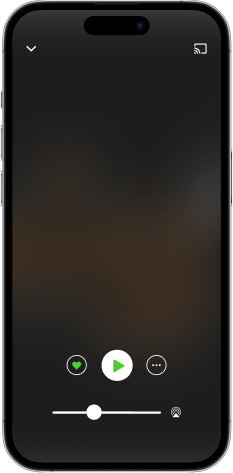

Latent Space: The AI Engineer Podcast
download de app,
luisteren.
